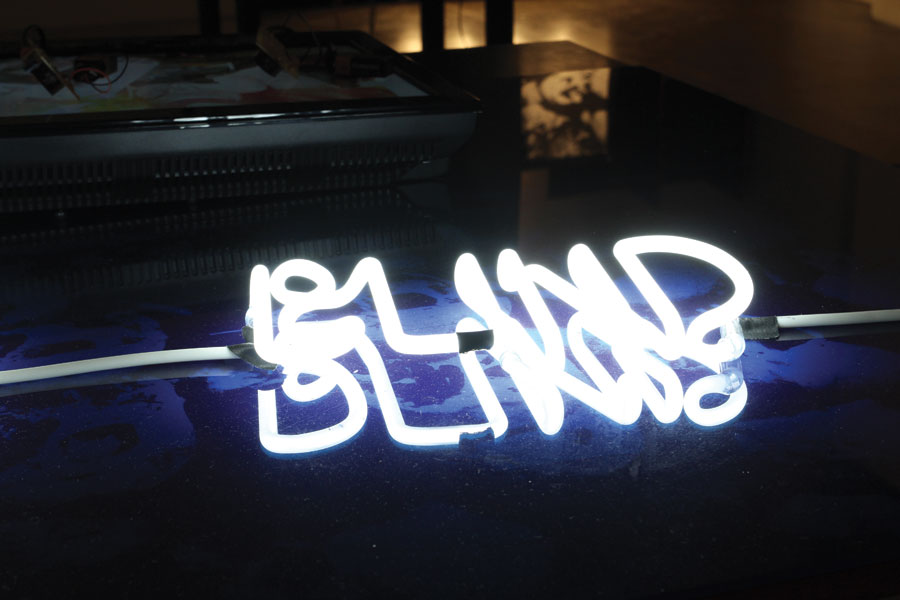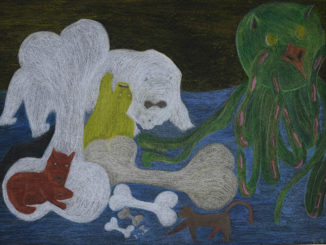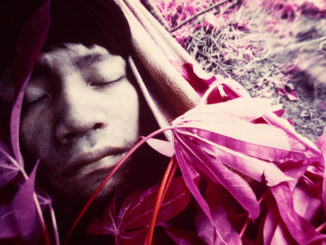
There’s very little that’s said in the first-person about Miami-based collective Viking Funeral. In a not-too-unfamiliar cryptic fashion, the two men who exist as Viking Funeral refuse to say precisely what they are about and what motivates them except for the pursuit, transmission and interpretation of information.
They say, “Viking Funeral started in 2006 as a project without a real definition and independent of any previous practices exercised by us. We are musicians and visual artists and at times are able to do both. Viking Funeral is an autonomous character.” Beyond that, their description of themselves as artists is frustratingly sparse. For a writer trying to make a qualitative assessment of Viking Funeral on little more than generalized statements about having no expectations or no practical direction, its damned irritating. Perhaps this is the intended effect: the placement of a thick veil of ambiguity adds to the fascination and curiosity behind the collective, without concrete facts or reflections on which to hang assumptions.
Here’s what is known from a secondary perspective: two young men named Carlos Ascurra and Juan González collaborate as Viking Funeral with multimedia projects meshing light, (a great deal of often ear-splitting) sound, space and imagery suggestive of an alignment to a counter-culture sect somewhere between deviant punk rock and heavy-handed philosophical musings. Notable selected projects include: “What Future” (2008), where Miami-based curator Gean Moreno and Juan Castro delivered Viking Funeral to the Circa Art Fair in San Juan, Puerto Rico, “Morte Certa” (meaning ‘certain death’ in Italian) debuted at the De la Cruz Collection’s space last year acting as an eloquent, re-imagined Italian horror film filtered through engineered sounds and was later accompanied by a 60-page publication (with a 7-inch record inside) commissioned by the De la Cruz Collection entitled Black Italian Leather (2010).
Arguably the most controlled, highly concentrated work that Viking Funeral has yet produced was their interactive installation “Jessie’s Girl” (2009) staged at Locust Projects. Set against a stark black background, odd fabric shapes and images of sunsets (probably last seen on the cover of a Trapper Keeper) were strewn about with teeny bopper images of Rick Springfield (in case some of us are too young, he’s the Aussie rocker who released “Jessie’s Girl” in 1981, received a Grammy and gradually faded away from popular memory. The song remains an unabashed late-night karaoke classic). The digestion of rock n’ roll sounds, filtered through impossibly scrambled sound systems and DJ decks augmented a darkened sense about the space as an active, theatrical stage. Without the presence of the two men, themselves, or any additional actors the installation rather remarkably morphed into performance. Using the premise of the song as a loose narrative, Viking Funeral had somehow exorcised the devil out of Rick Springfield. Whether the results were palatable was not the aim: the work set out to create a multi-sensory consideration of a small recess of pop culture and did exactly that.
From there, Viking Funeral has recently staged a hybrid exhibition/performance entitled “Dark Age Ahead” at the annex space of the Fredric Snitzer Gallery in Wynwood: a visual and auditory assault laden with pop-culture references and indiscernible, blaring noises which seem to appropriately encapsulate the insanity of the contemporary, Postmodern condition. This show, seemingly for the first time, accurately expresses the essential qualities of the duo: confused but aware, angry but calculated. Spray-painted, monstrous ephemera are sprawled over the walls in black, clashing with excessively innocent imagery of puppy dogs and open meadows overlaid with intellectually rigorous text. A bombardment of aesthetic detritus, Viking Funeral effectively denotes the ‘right’ image with what is inherently “wrong” about it. Their criticism of the truth and meaning of images is overt, without employing veils or subtleties. There is no immediate consideration for Viking Funeral as to whether or not their practice garners any sort of widespread appeal and, for that matter, widespread attention. The work ethic is reminiscent to artists past such as Adrian Morris, Cy Twombly and Banksy: despite their reluctance (or outright refusal) to fully cooperate with critics, galleries and buyers, their work became their voice.
Such an assessment may seem premature, but the evidence is resident in the results of their labors. “Dark Age Ahead” stands as a kind of compendium for the collective, as over time their modus operandi becomes more familiar to the local contemporary art community. If there is any popular frustration in appreciating or absorbing the creative output of Viking Funeral, it may be that their practice has taken on a distinctive brand: angry, loud, dark, almost hostile to anyone outside of their realm of perception. From a critical perspective (regardless of the amount, or lack thereof, of primary information) however, the collective remains buoyant and adaptable to curatorial suggestion and guidance. Their name, alone, opens up a wealth of associations with the ancient burial rites of legendary warriors and marauders all the way to the best possible name for a high school band (considered on a whim).
As elusive as they are in fully disclosing their methodologies, they had slyly let on of their aspirations of fame and fortune in a previous interview with locally celebrated artist Nicolas Lobo for ArtLurker last year, “It would be nice to become so successful that we become dickheads and we can’t talk to each other. Rich you know to the point were we can only communicate by E-mail.” Not to be taken out of context, however, Viking Funeral remains a rigorously maintained performative structure, a unique presence in Miami that remains an essential element in the larger aim of diversification.
Aspirations are key to every artist’s movement intellectually, so there’s to be no mistaking their commitment isn’t clouded over by the idea of selling souls. With the inclusion of texts and soundtracks inspired by Jean-Luc Goddard, Italian Horror and any manner of sound experimentation, Viking Funeral probes historic recesses not for answers, but for samples; pathways and outlets into the current moment which often have jarring, but engaging results. Their multi-layered projects are not exactly spoonfuls of sugar for those familiar with a tried-and-true gallery or commercial scenario. But recall the efforts of Marcel Broodthaers, Daniel Buren and Hans Haacke and the contextual threads becomes thicker: institutional critique shunned the use of objects as sensory fixations, but deployed them as triggers into larger creative investigations. Such attempts were considered blasphemous to viewers and critics, as their expectations of consumer-friendly works were answered with disdainful, rebellious polls, polemics and poetry.
With Miami slowly earning its designation as a developing cultural capital, there is little room to prevent alternative gestures such as Viking Funeral to be considered too vague, too hostile or too unknown. The larger contribution to the contemporary landscape has been made under the auspices of the city’s most respected curators and institutions, who have seen beyond the simple niggles of work without price tags, plinths or detailed descriptions. Viking Funeral has broken through the shiny veneer of the ‘safe’ gallery world and all of its charms with a potent vengeance; it would be unfair to call the young men, themselves, vengeful or angry as they are polite and soft-spoken in person. To change the game, play loud.



Be the first to comment